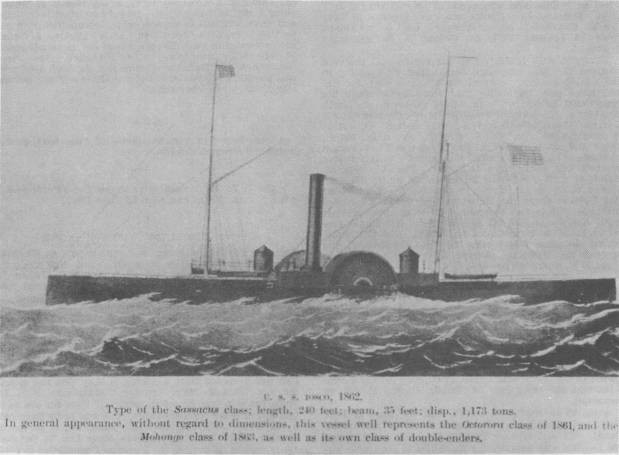Iosco (Side Wheel Gunboat)
1864-1868

(Side Wheel Gunboat: tonnage 974; length 205'0"; beam 35'0"; depth of hold 11'6"; speed 13 knots; complement 200; armament 2 100-pounder Parrott rifles, 4 9-inch Dahlgren smoothbores, 2 24-pounder howitzers, 1 heavy 12-pounder; class Sassacus)
Iosco, a wooden-hulled, double-ended, side-wheel gunboat, was launched by Larrabee & Allen, Bath, Maine, on 20 March 1863; and commissioned at the Boston [Mass.] Navy Yard on 26 April 1864, Cmdr. Andrew J. Drake in command.
Iosco was at New London, Conn., on 9 June 1864 when ordered to New York to complete her crew. Subsequently, Iosco sailed for the Gulf of St. Lawrence on 28 August 1864 to protect American fishing vessels in that vicinity. Off Nova Scotia and Prince Edward Island, she assisted several ships endangered by fierce storms. She towed General Burnside off a reef on 15 September and aided the battered Colonel Ellsworth and the English bark Empress two days later.
Ordered to Hampton Roads on 2 October 1864 to join the First Division of the North Atlantic Blockading Squadron, Iosco was stationed off Wilmington, N.C. where she captured the British schooner Sybil attempting to escape to sea with 307 bales of cotton on 21 November.
On Christmas Eve 1864, Iosco participated in the first amphibious attack on Fort Fisher, N.C. which protected Wilmington, one of the South's most active centers of blockade running and her last port of entry for European aid. Her guns engaged the batteries at Mound Fort and succeeded in shooting down the Confederate flag which flew above the works. During the firing a Confederate shot carried away the head of Iosco’s foremast. The next day, she led nine other ships in an attack on the fortress, closing the shore as near as her draft would permit. Meanwhile her boats dragged the channel for torpedoes [mines]. Throughout the operation, she protected the right flank of the Union troops ashore until they re-embarked under orders from the Army commander, Major General Benjamin F. Butler on 27 December 1864, two days after Christmas.
A fortnight later, Iosco was again in the thick of the fighting during the second attack on Fort Fisher. She assisted the landing of troops and covered the right flank of the Army as it fought on shore on 13 January 1865. Forty-four of her sailors fought beside the soldiers on the beaches while her cannon fired at the Mound Fort until the Confederates surrendered on 15 January.
The remainder of Iosco’s wartime service was in the North Carolina Sounds carrying out operations as Confederate resistance ceased. She sailed north on 15 July 1865 and decommissioned on 28 July 1865. Her engines were removed and her hull turned over to the Bureau of Construction and Repair for service as a coal hulk at the New York Navy Yard, Brooklyn, N.Y., in February 1868.
Updated, Robert J. Cressman
29 June 2022
Iosco (AT-29) was renamed Tatnuck (q.v.) 24 February 1919.


